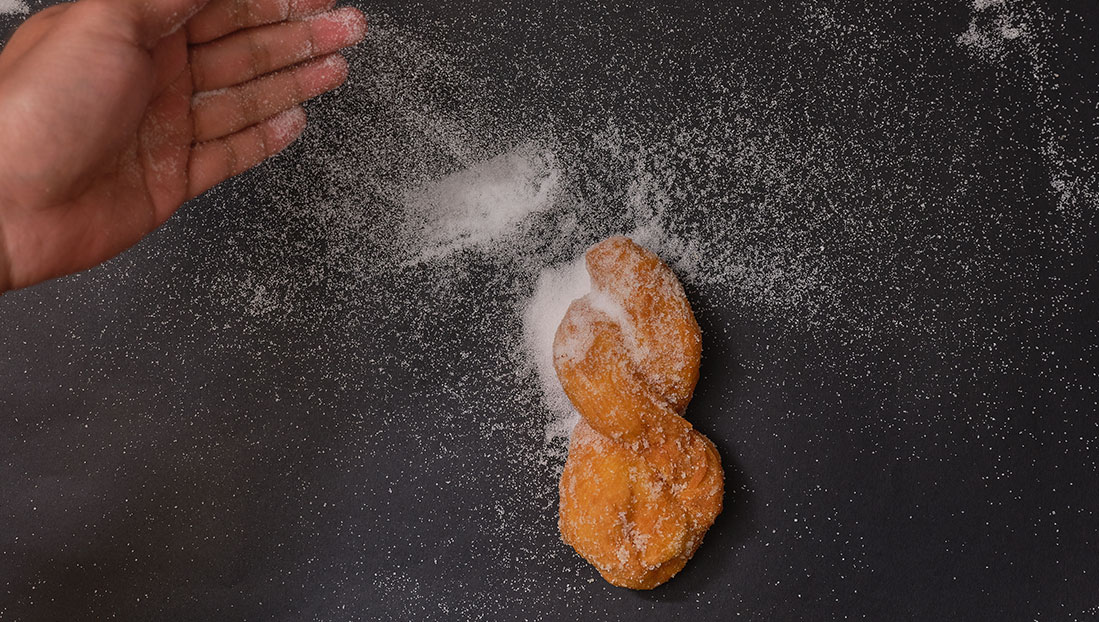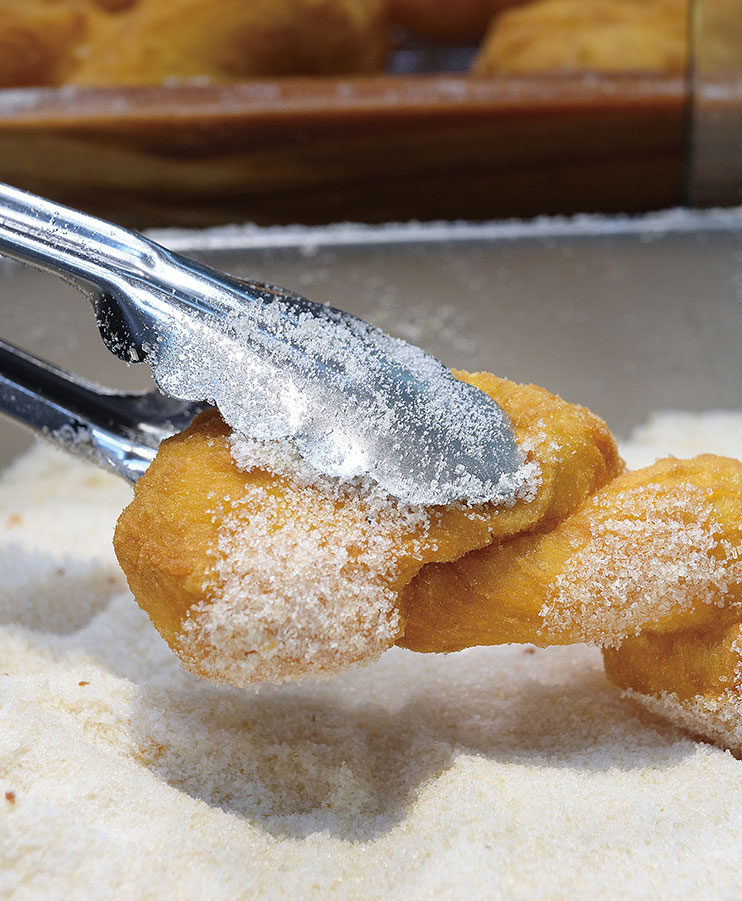Flavor
Twisted Appeal
Kkwabaegi>/i>
A simple snack appealing to the universal appreciation for sweet carbs is kkwabaegi (twisted doughnut), which is named for its shape kneaded from two strands. Its form allows little room for filling or condiments, but the snack’s signature sprinkling of sugar hardly spurs further cravings.
Written by
• Kim Jane
Photographed by• Studio Kenn
Besides its shape, how else does kkwabaegi differ from a traditional doughnut? The Korean snack is distinctly chewy, a hallmark quality attributed by chapssal (sticky or glutinous rice) dough.
Sugar, dough and frying oil are the only ingredients the standard kkwabaegi needs besides a fermenting agent such as liquor or yeast. Contrary its more conventional uses, sugar supplements kkwabaegi more as a topping.
Variations of kkwabaegi mostly comprise traditional paste like pat (red bean), heugimja (black sesame) and konggomul (powdered soybean). Besides pat, which Korean bakeries frequently stuff various pastries with or use as preserves, heugimja and konggomul complement kkwabaegi in powdered form. Otherwise, the doughnut lacks the optimal shape to contain filling or even other spices.
Perhaps for that reason, innovation in the twisted doughnut kkwabaegi has remained limited. Unlike the majority of popular Korean snacks that switch flavors with every passing trend, kkwabaegi has been largely left behind in seasonal fads. Vendors are likelier to add similar items to the menu like churros, regular doughnuts, kkorokke (Japanese croquette) or corn dogs rather than expand their menu with variants. kkwabaegi is usually savored in its original sugary state or with traditional grain-based seasoning.

(in regular order) Twisting chapssal (glutinous rice) dough requires the right touch. / A batch of twisted dough. / A batch of kkwabaegi (twisted doughnuts) is fried in oil.
‘Newtro’ Comeback

According to the Korea Fair Trade Mediation Agency, the number of kkwabaegi franchises more than doubled between late 2018 and early 2020. Delivery Hero, better known under the name of the app Yogiyo, Korea’s top food delivery app, reported an astounding annual surge of 2,430% in orders for kkwabaegi from 2018-19.
The snack didn’t always boast high demand. Coinciding with the entry into Korea of Dunkin’ Donuts (and later Krispy Kreme) in the 1990s, kkwabaegi fell largely out of fashion. Its recent surge in popularity, however, is attributed to “newtro,” a portmanteau combining the words “new” and “retro.” In most categories from fashion, music and food to photography, young people have either revived retro or vintage themes or found new value in them.
A commercial variant of kkwabaegi is the honey-flavored version presented as a bag of chips. On sale for nearly half a century, this version used to hold a more conspicuous presence back when prepackaged goods were considerably limited in option. Today, with grocery aisles packed with trend-savvy grub, honey kkwabaegi remains a modest specialty with vintage charm.
Origin & Peers
Before its industrialization several decades ago, Korea was neither wealthy nor rich in Western ingredients like flour. According to ancient historical documents like “The Annals of the Joseon Dynasty”, kkwabaegi was around even during Korea’s isolationist period prior to the eventual influx of Western influence. Based on this record as well as others, the treat is thought to have originated from China’s Hangzhou region.
The Chinese version of the twisted snack, called “yóutiáo,” is different in texture and more solid like crackers or jumbo-size versions of honey-flavored kkwabaegi, and was initially consumed on holidays and other occasions.
North Korean leader Kim Jong Il is known to have an affinity for kkwabaegi. Nationwide celebrations of his birthday customarily feature cooking competitions in which loads of the doughnuts are reportedly served. Since he boosted his country’s main flour manufacturer by boosting a flour processing factory in Pyeongyang and its hallmark kkwabaegi brand, Chilgol, a decade ago, he has kept the pastry supply replete under his close supervision. The bountiful supply chain naturally spurred other North Korean eateries and food providers to add the twisted doughnut to their menus, boosting its popularity.
The enduring appeal of kkwabaegi is not thanks to its plain and cheap ingredients but rather its chewy texture that differentiates the snack’s original version from its peers. This explains its longstanding presence in the trend-sensitive nation. Because the frying process is taken seriously, kkwabaegi merchants tend to be called things like jangin (master), whether on TV or online, and this also explains why kkwabaegi is rarely made at home despite its common ingredients.

A doughnut is dipped in sugar.




















